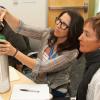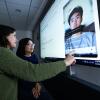
School of Nursing professors Elizabeth Gatewood and Matt Tierney collaborated with Scott Steiger at the School of Medicine to develop a course fast-tracking the process for health care professionals to treat patients battling addiction. (iStock)
Amid the Opioid Epidemic, New Course Prepares Students to Treat Patients for Addiction
In recent years, opioid overdoses have surpassed auto accidents as the leading cause of accidental death for adults in the United States, according to the U.S. Centers for Disease Control.
One of the major hurdles to providing treatment for opioid use is a lack of doctors and nurses trained to treat it, since health professionals must take additional classes to prescribe certain medicines.
Physicians must take an eight-hour course and nurse practitioners 24 hours of training to legally prescribe a drug called buprenorphine (known by numerous trade names including Subutex), an opioid used to treat addiction. Both courses are available online, but for practitioners already working in the field, finding time for the required outside education can be a challenge.
“We said, ‘Let’s catch them while they’re still in school and show them state-of-the-art-treatment for opioid use disorder,’” said Scott Steiger, an associate professor of Medicine at UC San Francisco.
Steiger, along with several colleagues from the School of Nursing, created a course called “Inter-Professional Approach to the Treatment of Opioid Use Disorder” which is supported by grant funding from the Substance Abuse and Mental Health Services Administration (SAMHSA).
“Because UCSF trains so many leaders in the medical and nursing fields”, Steiger said, “we can mint these people who, down the line, will be leading clinics and organizations. And when they encounter a patient dealing with opioid use disorder, they’ll be able to treat that person right then and there.”
 Elizabeth Gatewood, Matt Tierney Nursing professors Elizabeth Gatewood and Matt Tierney had already been talking about putting together a course for nursing students when they saw the call for proposals from SAMHSA. They invited Steiger to help them develop the course. “We thought it would be great to make it interprofessional because we’re treating this condition in an interprofessional setting,” said Gatewood.
Elizabeth Gatewood, Matt Tierney Nursing professors Elizabeth Gatewood and Matt Tierney had already been talking about putting together a course for nursing students when they saw the call for proposals from SAMHSA. They invited Steiger to help them develop the course. “We thought it would be great to make it interprofessional because we’re treating this condition in an interprofessional setting,” said Gatewood.
Read the full story.



